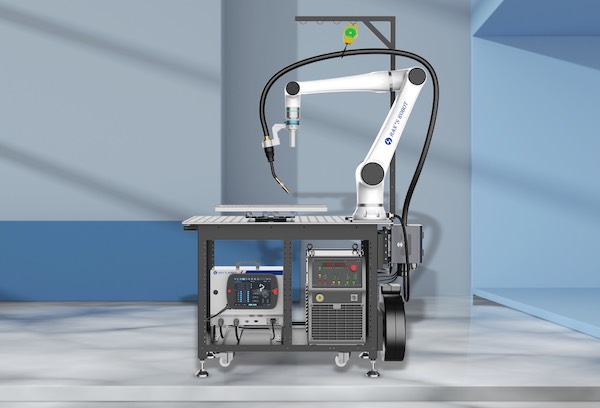Welding Automation with Cobots: Unlocking New Levels of Efficiency
Welding, an essential process across various industries, has traditionally been labor-intensive. However, with advancements in robotics and automation, integrating cobots (collaborative robots) in welding processes is revolutionizing the industry. This article explores the transformative potential of welding automation with cobots, focusing on unlocking new levels of efficiency.

Understanding Cobots in Welding Automation
Cobots are designed to collaborate with humans, unlike traditional industrial robots, which often require safety cages. These robots are equipped with sensors and intelligent programming, enabling them to perform tasks precisely and flexibly.
Integrating cobots into welding processes offers several advantages. Cobots can improve productivity by working continuously without breaks, leading to faster production cycles. Additionally, they enhance safety by reducing the risk of workplace accidents, as they can operate near human workers.
Safety is paramount when implementing cobots in welding environments. Cobots have advanced safety features such as collision detection sensors and speed control mechanisms to prevent accidents. However, organizations must conduct thorough risk assessments and provide proper training to ensure safe operation.
The Role of Artificial Intelligence in Welding Automation
Artificial intelligence (AI) plays a crucial role in optimizing welding processes. AI-driven welding automation systems utilize algorithms to analyze data from sensors and make real-time adjustments to welding parameters, resulting in improved efficiency and quality.
Machine learning algorithms are employed to optimize welding parameters such as voltage, current, and travel speed. These algorithms learn from historical data and adapt to changing conditions, enabling precise control over the welding process and minimizing defects.
AI enables predictive maintenance by analyzing sensor data and equipment failures before they occur. Moreover, AI-powered quality control systems can detect defects in real-time or unreal timensuringand, and only high-quality welds are produced.
Implementing Welding Automation with Cobots
Before integration, careful design considerations are necessary. This includes integrating cobots into welding processes, assessing the layout of the workspace, identifying potential hazards, and determining the optimal placement of cobots for maximum efficiency. Cobots should seamlessly integrate with existing welding infrastructure, including welding machines, fixtures, and workpieces. Compatibility testing is essential to ensure smooth operation and minimal disruption to production.
Operator training and re-skilling are essential for successfully implementing welding automation with cobots. Operators must be familiar with cobot programming, operation, and maintenance to collaborate effectively with these robots. A thorough cost-benefit analysis is critical to evaluating cobot integration’s return on investment (ROI). While the initial investment may be significant, the long-term benefits of increased productivity, reduced labor costs, and improved quality justify the expense.
Overcoming Challenges in Welding Automation with Cobots
Safety is a primary concern when deploying cobots in welding environments. Compliance with safety regulations and standards, such as ISO 10218 and ANSI/RIA R15.06, is essential to ensure the well-being of human workers. Cobots should be capable of performing a wide range of welding processes, including MIG, TIG, and arc welding robots. Compatibility with different materials and thicknesses is necessary to accommodate diverse production requirements.
While cobots excel at repetitive tasks, they may need help with complex welding tasks that require intricate maneuvers or specialized techniques. Advanced programming and tooling solutions are necessary to address these challenges effectively. Regular maintenance and troubleshooting are essential to ensure the smooth operation of cobots. Organizations should establish comprehensive maintenance schedules and protocols for diagnosing and resolving issues promptly.
Maximizing Efficiency and Productivity
Cobots can optimize workflow by automating repetitive tasks, allowing human workers to focus on more complex and value-added activities. This leads to increased throughput and reduced cycle times. Automation reduces downtime by eliminating the need for breaks and shift changes. Cobots can operate continuously, maximizing production uptime and minimizing idle time.
Monitoring performance metrics such as cycle time, throughput, and defect rate is crucial for identifying areas for improvement. Data analytics tools can provide valuable insights into production efficiency and quality. Continuous improvement is essential for maintaining competitiveness in the welding industry. Organizations should implement lean manufacturing principles and regularly review and optimize their processes to drive efficiency gains.
Future Trends and Innovations
Advancements in robotics, AI, and IoT technologies mark the future of welding automation. Collaborative robots with enhanced capabilities, such as autonomous navigation and adaptive learning, will further revolutionize the industry. Integration with Industry 4.0 technologies, such as cloud computing and IoT, will enable real-time monitoring and control of welding processes. Smart factories with interconnected devices will facilitate seamless collaboration between humans and cobots.
The widespread adoption of welding automation with cobots will reshape the manufacturing landscape, driving increased productivity, efficiency, and quality. Organizations that embrace these innovations will gain a competitive advantage in the global market.
Conclusion
Welding automation with cobots offers a transformative solution for unlocking new manufacturing efficiency levels. By leveraging advanced technologies such as AI and robotics, organizations can streamline their welding processes, improve productivity, and ensure the highest quality and safety standards. As the industry continues to evolve, embracing these innovations will be essential for staying ahead of the curve and driving sustainable growth.